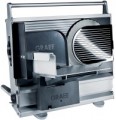Blade type
The type of blade that comes standard with the slicer.
All knives used in this category of kitchen appliances are circular, rotating, and the blade in them goes in a circle. But the shape of this blade can be different — it is in this parameter that the types of knives differ from each other.
—
Straight. Knives with a traditional straight blade are basic and affordable, yet with proper sharpening and skill, they can handle various slicing tasks effectively. They excel with products of uniform consistency like cheese but may be less effective for slicing non-uniform density items such as bread compared to knives with wavy or notched blades.
—
Wavy. Knives with a wave-shaped blade are more difficult to manufacture and more expensive than straight ones. On the other hand, they do an excellent job not only with homogeneous products, but also with those that have different density — like ham with a crust.
—
Serrated. Serrated knives have sharpening in the form of pronounced sharp teeth, resembling those of a circular saw. They are beneficial for slicing products with varying density, similar to wavy blades. Serrated knives are particularly effective for cutting vegetables and fruits with tough peels and soft cores, like tomatoes or peaches. However, these knives tend to be more expensive due to their specialized design.
No
...te that some models may come with several removable blades of different types. This allows you to choose an option depending on the situation — for example, cut the cheese with a straight knife, and put the wavy one only when really necessary, so as not to wear it out much.Max. thickness of slice
The greatest thickness of the slices that the slicer can separate from the cut product.
The modern slicers usually allow you to adjust the thickness of the slices — an important feature in light of the fact that for different situations and products, the optimal thickness will be different. The ability to separate thick slices can be useful, for example, when cutting bread, or when preparing fruit for jam or compote. Such situations are not uncommon, therefore, in most modern slicers, the maximum thickness is more than 10 mm.
Pulse mode
Possibility of work of a slicer in the
pulse mode. In this mode, in accordance with the name, the knife of the device works nonuniformly — high speed alternates with short pauses. Pulse switching is well suited for working with dense and solid products: it allows you to develop a higher working speed than with uniform work, at the same time it does not allow overloading the knife and reduces the chance of jamming. However, even in such models, there is usually no question of cutting fruit pits or other equally solid ingredients — slicers are not designed for this in principle.
Slicing tray
The presence
of a tray for chopped products in the design or delivery set of the slicer.
Such a pallet can be made both as a non-removable element and as a separate device that is not attached to the slicer body. However, this piece of equipment saves the user from having to look for a board, saucer, plate or other "seat" for chunks coming out from under the knife of the unit anyway. Of course, in a modern kitchen, finding such a “seat” is not a problem, but using a tray is often more convenient.
Foldable
The ability
to fold the slicer when it is not in use.
The meaning of folding in slicers is the same as in any other technique — it allows you to reduce the dimensions of the unit and make it more convenient for storage and moving from place to place. However the folding structure is considered less durable and reliable than the unibody; however, in this case, this difference is not fundamental.
Also note that this category also includes such a specific variety as built-in slicers — without the possibility of folding, such devices would be too bulky and would cause inconvenience when embedded.
Material
The main material used in the construction of the slicer.
—
Plastic. This material is characterized by low cost and is often used in inexpensive models. However, its use is not an unambiguous sign that the slicer belongs to the low-cost class. The fact is that although the reliability of plastic is considered relatively low (compared to metal), it is quite sufficient even for fairly powerful models. In addition, there are many varieties of this material on the market, including options with high strength rates. Therefore, the actual strength and reliability of plastic is usually directly dependent on the price category of the slicer.
—
Metal. On the practical side, metal is remarkable for its high strength: it is much more difficult to damage such a body than plastic. In addition, it gives the device a solid appearance. The disadvantage of this material is a higher cost — despite the fact that the real need for the mentioned strength indicators is quite rare.

